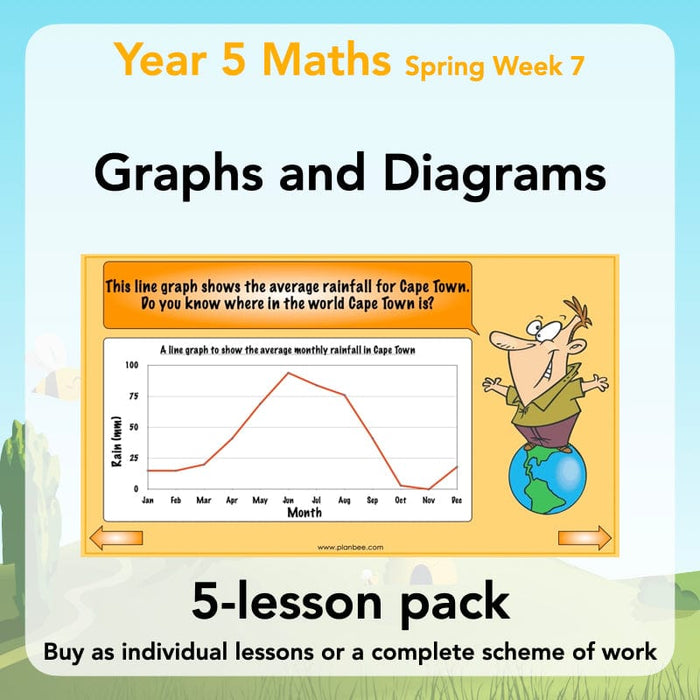

Teach children to read, interpret and create line graphs – and use the information presented in line graphs to solve a variety of comparison, sum and difference problems.
These five 'Graphs & Diagrams' lesson planning packs for Year 5 focus on presenting data in a variety of ways, including using line graphs. Your class will develop their data handling skills as they learn how and why line graphs are used, how to create line graphs and points accurately. They'll develop skills for interpreting line graphs, including those with multiple sets of data shown.
The five detailed lesson plans each come with slides which explain how to read, interpret and construct graphs, and give examples of real-life graphs and data sets for children to work with. Each lesson also comes with a choice of differentiated learning activities where your pupils can apply what they've learnt using the line graph worksheets, activity cards, games and other supporting resources.
Reading Scales
Learn all about reading scales, including unnumbered scales showing decimals and negative numbers.
In this lesson, the first of five in 'Graphs and Diagrams' for Year 5, children will develop the skills needed to read and interpret data presented in a variety of graphs. They'll look at several different, unnumbered scales and identify the value at different points along them. The ability to read scales accurately is essential for interpreting data shown on graphs; for that reason, this lesson's included slides and activities provide plenty of opportunities for children to practise.
In preparation for children to handle data such as temperatures, the slides and differentiated reading scales worksheets also show scales with negative numbers.
What's included:
- Lesson plan
- Slides
- Activity ideas
- Differentiated worksheets
Interpreting Line Graphs
Take a look at line graphs and how they are constructed, then teach children how to interpret information in line graphs with simple scales.
In this Year 5 lesson, children will firstly learn about the features of line graphs, then practise interpreting line graphs as they answer questions about the information shown on the slides. After that, there's a choice of differentiated learning activities where children will construct their own simple line graphs, either using given sets of data or by sourcing some data of their own.
This is the second of five lesson plan packs included with the 'Graphs and Diagrams' KS2 statistics scheme of work.
What's included:
- Lesson plan
- Slides
- Activity ideas
- Differentiated worksheets
- Challenge cards
Interpreting Continuous Data
Teach children all about interpreting continuous data presented using line graphs, and how to compare different sets of continuous data, too.
In this challenging Year 5 lesson (the third of five lessons included in 'Graphs & Diagrams' for KS2), children will take a look at continuous data. They'll start to get a sense of what it is, and why line graphs are helpful for reading and interpreting this kind of data.
The included slides help answer the question "What is continuous data?" by showing how to read intermediate points on a line graph. After the teaching input, there's a choice of differentiated learning activities with supporting line graph worksheets and information sheets, where children will practise their newly learnt skills for reading and interpreting continuous data.
What's included:
- Lesson plan
- Slides
- Activity ideas
- Differentiated worksheets
- Information sheet
Drawing Line Graphs
Challenge children to think about the scales they will need to use as they begin drawing line graphs of their own.
This lesson's included slides begin by showing your KS2 class a line graph to interpret before giving them the chance to construct their own line graphs. They'll be shown the methods they need for selecting appropriate scales and plotting data points accurately. To help children practise their line graph drawing skills there's a choice of differentiated learning activities with worksheets, too. A more challenging activity for your higher-attaining learners is included, where they'll be challenged to construct a line graph with more than one line.
This is the fourth of five lessons included in the 'Graphs & Diagrams' scheme of work for Year 5.
What's included:
- Lesson plan
- Slides
- Activity ideas
- Differentiated worksheets
Line Graph Questions
Challenge children to apply their line graph knowledge and skills as they attempt to answer a variety of line graph questions.
In this, the fifth of five KS2 Maths lessons included in 'Graphs and Diagrams' for Year 5, children are challenged to solve a variety of line graph problems by interpreting data presented in graphs, or by constructing line graphs of their own.
The included slides start by showing ways in which multiple sets of data can be presented using a range of different charts and graphs. They go on to show your pupils some features of line graphs such as legends. After that, they're challenged to answer questions about the line graphs shown, then go on to construct their own line graphs which show multiple sets of data.
What's included:
- Lesson plan
- Slides
- Activity ideas
- Differentiated worksheets






























































